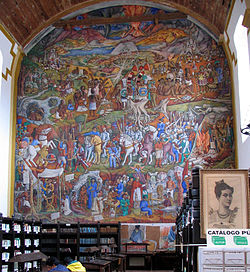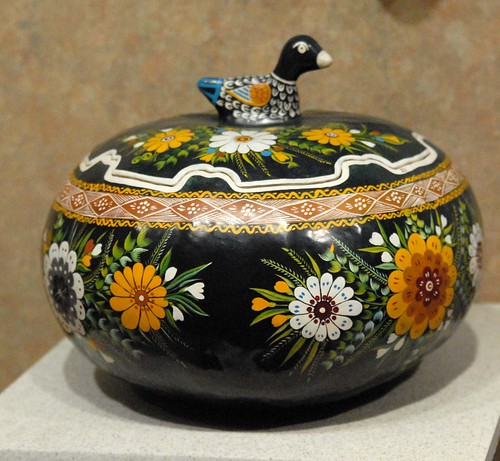First period
First sanctuaries - chaytia-grihas - in the up to 75 metres deep canyon of Waghora River were created during the Satavahana dynasty in 2nd - 1st century BCE. Several sanctuaries (including sanctuaries No. 9, 10, 19, 26) were made. Murals preserved from this time belong to the oldest monuments of painted art in India.
Second period
There exists scientific controversy regarding the length and time of the second period of Ajanta Caves. While earlier it was considered that caves have been shaped over a longer period of time in 4th - 7th centurys, recently long-time researcher of Ajanta Caves Walter M. Spink considers that most activities have taken place in short time period from 460 - to 480 AD during the reign of Vakataka dynasty, emperor Harishena. At this time there took place simultaneous work of creating some 20 cave temples, for most part viharas - monasteries with sanctuary in the rear centre of structures. Each of cave temples seem to be patronised by influential authority, numerous best available artists have been involved in the work with fruitful rivalry between the neighbouring construction sites.
According to Spink, Ajanta Caves seem to be abandoned shortly after the fall of Harishena circa 480 AD. Since then these temples have been abandoned and gradually forgotten. During the next 1300 years the jungle grew back and the caves were hidden, unvisited and undisturbed.
Rediscovery by Europeans
In 28th April 1819 British officer in the Madras army John Smith during the hunt of tiger accidentally discovered entrance in one of the cave temples (No. 9) deep within the tangled undergrowth. Exploring that first cave, long since a home to nothing more than birds and bats and a lair for other, larger, animals, Captain Smith wrote his name in pencil on one of the walls. Still faintly visible, it records his name and the date, April 1819.
Shortly after this discovery Ajanta Caves became well known and renowned due to their exotic setting, impressive architecture, artworks and mysterious, long forgotten history.
Cave One
It is first approach and has no relation to the chronological sequence of the caves. It is the first cave on the eastern end of the horse-shoe shaped scarp. According to Spink, it is one of the latest caves to have begun on site and brought to near-completion in the Vākāţaka phase. Although there is no epigraphic evidence, it has been proposed that the Vākāţaka king Harisena may have been the benefactor of this better-preserved cave. A dominant reason for this is that Harisena was not involved initially in patronizing Ajanta.
This cave has one of the most elaborate carvings on its facade with relief sculptures on entablature and ridges. There are scenes carved from the life of the Buddha as well as a number of decorative motifs. A two pillared portico, visible in the 19th-century photographs, has since perished. The cave has a front-court with cells fronted by pillared vestibules on either side. These have a high plinth level. The cave has a porch with simple cells on both ends. The absence of pillared vestibules on the ends suggest that the porch was not excavated in the latest phase of Ajanta when pillared vestibules had become a necessity and norm. Most areas of the porch were once covered with murals, of which many fragments remain. There are three doorways: a central doorway and two side doorways. Two square windows were carved between the doorways to brighten the interiors.
Each wall of the hall inside is nearly 40 feet (12 m) long and 20 feet (6.1 m) high. Twelve pillars make a square colonnade inside supporting the ceiling, and creating spacious aisles along the walls. There is a shrine carved on the rear wall to house an impressive seated image of the Buddha, his hands being in the dharmachakrapravartana mudra. There are four cells on each of the left, rear, and the right walls. The walls are covered with paintings in a fair state of preservation. The scenes depicted are mostly didactic, devotional, and ornamental. The themes are from the Jataka stories (the stories of the Buddha's former existences as Boddhisattva), the life of the Gautama Buddha, and those of his veneration.
Cave Two

Painting from the Ajanta caves
Cave 2, adjacent to Cave 1, is known for the paintings that have been preserved on its walls, ceilings, and pillars. It looks pretty much the same as Cave 1 and is in a better state of preservation.
The facade
Cave 2 has a porch quite different from Cave one. Even the facade carvings seem to be different. The cave is supported by robust pillars, ornamented with designs. The size and ground plan have many things in common with the first cave.
The porch
The front porch consists of cells supported by pillared vestibules on both ends. The cells on the previously "wasted areas" were needed to meet the greater housing requirements in later years. Porch-end cells became a trend in all later Vakataka excavations. The simple single cells on porch-ends were converted into CPVs or were planned to provide more room, symmetry, and beauty.
The paintings on the ceilings and walls of this porch have been widely published. They depict the Jataka tales that are stories of the Buddha's life in former existences as Bodhisattva. The porch's rear wall has a doorway in the center, which allows entrance to the hall. On either side of the door is a square-shaped window to brighten the interior.
The hall
The hall has four colonnades supporting the ceiling and surrounding a square in the center of the hall. Each arm or colonnade of the square is parallel to the respective walls of the hall, making an aisle in between. The colonnades have rock-beams above and below them. The capitals are carved and painted with various decorative themes that include ornamental, human, animal, vegetative, and semi-divine forms.
[edit] The paintings
Paintings are all over the cave except for the floor. At various places the art work has become eroded due to decay and human interference. Therefore, many areas of the painted walls, ceilings, and pillars are fragmentary. The painted narratives of the Jataka tales are depicted only on the walls, which demanded the special attention of the devotee. They are didactic in nature, meant to inform the community about the Buddha's teachings and life through successive births. Their placement on the walls required the devotee to walk through the aisles and 'read' the narratives depicted in various episodes. (Alas, to prevent vandalism, entry into the aisles is restricted by site authorities). The narrative episodes are depicted one after another although not in a linear order. Their identification has been a core area of research since the site's rediscovery in 1819 C.E. Dieter Schlingloff's identifications have updated our knowledge on the subject.
For quite some time the art work was erroneously alluded to as "frescoes". We now know that the proper term for this kind of artwork is mural, because the known process and technique of fresco painting isn't found in this kind of artwork. At Ajanta, the technique and process used to produce this kind of artwork is unlike any other artwork found in the art history of other civilizations. These murals have a certain uniqueness about them, even within the history of South Asian art.
The process of painting involved several stages. The first step was to chisel the rock surface, to make it rough enough to hold the plaster. The plaster was made of clay, hay, dung and lime. Differences are found in the ingredients and their proportions from cave to cave. While the plaster was still wet, the drawings were done and the colors applied. The wet plaster had the capacity to soak the color so that the color became a part of the surface and would not peel off or decay easily. The colors were referred to as 'earth colors' or 'vegetable colors.' Various kinds of stones, minerals, and plants were used in combinations to prepare different colors. Sculptures were often covered with stucco to give them a fine finish and lustrous polish. The stucco had the ingredients of lime and powdered seashell or conch. The latter afforded exceptional shine and smoothness. In cave upper six, some of it is extant. The smoothness resembles the surface of glass. The paint brushes used to create the artwork were made from animal hair and twigs.
http://en.wikipedia.org/wiki/Ajanta_caves

Ajanta Caves, Maharashtra, India






















































